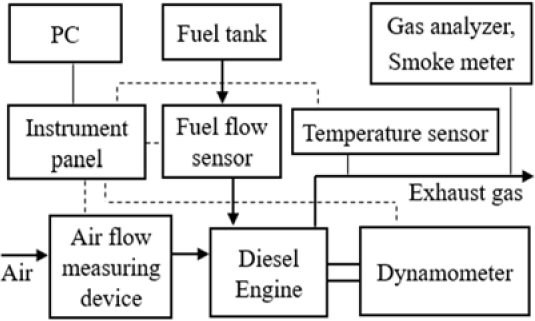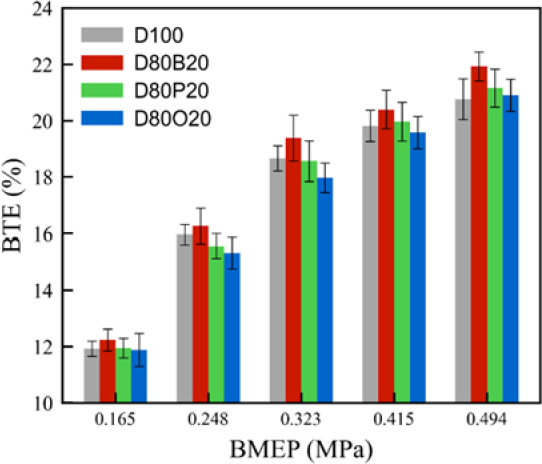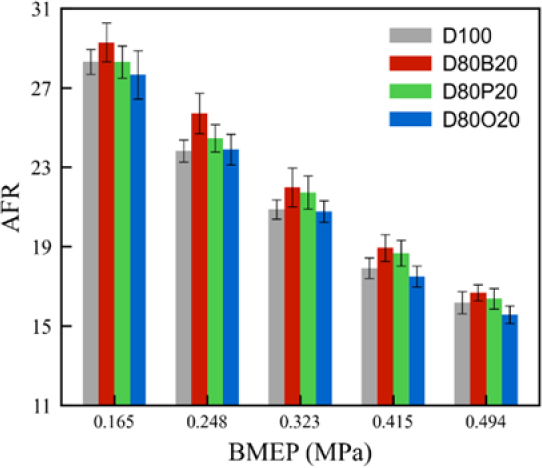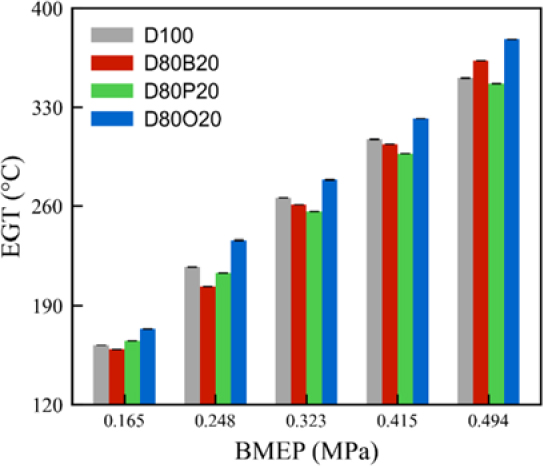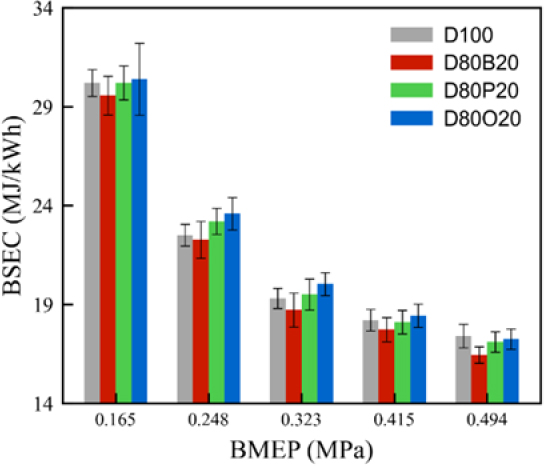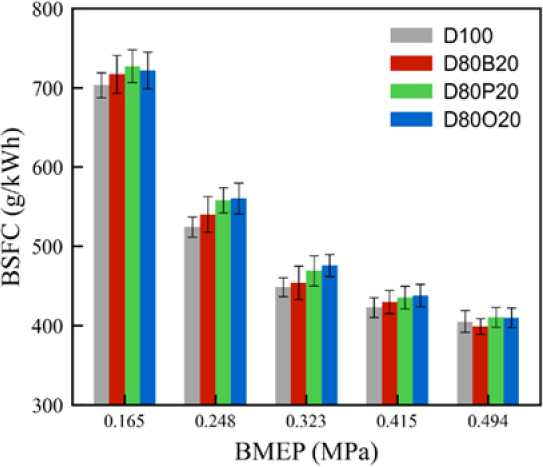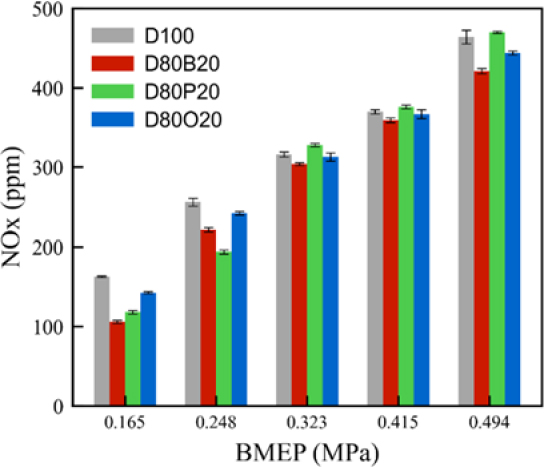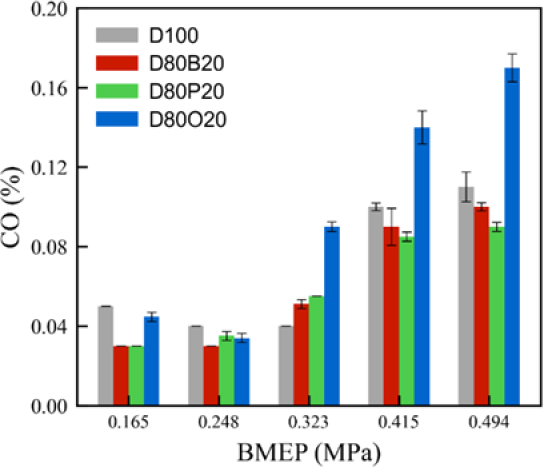
Comparative assessment of the effects of higher alcohols/diesel blends on performance and emissions of a direct-injection diesel engine
Copyright © The Korean Society of Marine Engineering
This is an Open Access article distributed under the terms of the Creative Commons Attribution Non-Commercial License (http://creativecommons.org/licenses/by-nc/3.0), which permits unrestricted non-commercial use, distribution, and reproduction in any medium, provided the original work is properly cited.
Abstract
This study evaluates the effects of incorporating 20% v/v concentrations of higher alcohols (1-butanol, 1-pentanol, and 1-octanol) into diesel fuel on the performance and emission characteristics of a direct-injection diesel engine. Through experimentation, we discovered that the 1-butanol blend (D80B20) notably enhanced the brake thermal efficiency (BTE) across various brake mean effective pressure (BMEP) values, signifying a marked improvement in combustion efficiency over conventional diesel fuel. Additionally, D80B20 demonstrated a significant reduction in carbon monoxide and nitrogen oxide emissions, along with a considerable decrease in smoke opacity, suggesting a cleaner combustion process attributable to the high oxygen content and favorable volatility of 1-butanol. Although the 1-pentanol blend (D80P20) moderately improved BTE and reduced smoke opacity at specific BMEP levels, its benefits were less pronounced than that of D80B20. The 1-octanol blend (D80O20), however, faces challenges at higher loads, with exhaust gas temperatures often surpassing those of pure diesel, indicating less effective combustion owing to the longer carbon chain of 1-octanol. Our findings highlight the potential of alcohol–diesel blends, especially D80B20, in significantly enhancing engine performance and reducing environmental impact through lower emissions. Thus, selecting appropriate alcohol types and optimizing blend ratios will provide environmental and operational benefits for diesel engines.
Keywords:
Diesel engine, 1-butanol, 1-pentanol, 1-octanol, Brake thermal efficiency, NOx, Smoke opacity1. Introduction
In response to the escalating global energy demands and challenges of environmental pollution, research on sustainable and clean alternative fuels has become imperative. Among the various internal combustion engines, diesel engines, distinguished by their high efficiency and reliability, are extensively used in the transportation sector [1][2]. The emission of exhaust gases from diesel engines, however, is detrimental to both the environment and human health, which necessitates continued research into combustion technology optimization and miniaturization as well as exploring the applicability of diverse alternative fuels.
Alcohols produced from biomass serve as renewable energy sources and display significant variations in their physicochemical properties based on the number of carbon atoms in their molecules and their bonding structures. Among the various alcohol fuels, ethanol and methanol, which are categorized as lower alcohols, have been the subject of extensive research and are used as fuels in gasoline engines in several countries, including Brazil and the United States [3][4]. Lower alcohols effectively reduce nitrogen oxides (NOx) and particulate matter (PM), and their high octane numbers improve engine performance and efficiency. However, their low energy density and hygroscopic nature can cause fuel system corrosion, and their poor coldstart performance makes them unsuitable for use in compression-ignition diesel engines in cold environments. Moreover, owing to the difficulties in mixing lower alcohols with diesel, dual injection strategies or design modifications may be required when using them in diesel engines to ensure fuel mixture stability and enhance corrosion resistance [5][6].
Conversely, higher alcohols, such as butanol and pentanol, demonstrate compatibility with compression-ignition diesel engines, owing to their favorable properties. Specifically, butanol and pentanol exhibit relatively high energy densities and cetane numbers, which enhance engine performance and combustion efficiency. A notable attribute of these higher alcohols is their hydrophobic nature, which significantly reduces the risk of fuel system corrosion by preventing the mixing with water. This characteristic is particularly beneficial for maintaining the integrity and longevity of the diesel engine components. Previous studies have shown that blends containing n-octanol, diesel, and biodiesel prevent phase separation and enhance combustion and emission characteristics, highlighting the suitability of higher alcohols for diesel engine applications [7][8]. Similarly, blending higher alcohols, such as butanol and pentanol, with diesel has been observed to improve engine performance and reduce harmful emissions without necessitating any modifications to existing diesel engines [9]-[11].
Previously, high production costs and supply constraints of higher alcohols limited their practical application as alternative fuels. However, recent advancements in biotechnological methods, including the genetic manipulation of microorganisms and innovative synthesis pathways, have substantially increased the production potential of higher alcohols [12]. The production of higher alcohols via the catalytic conversion of syngas derived from biomass gasification represents a significant advancement. This approach not only leverages renewable resources but also contributes to greenhouse gas mitigation by incorporating the carbon dioxide capture and utilization processes into its production cycle. Specifically, the integration of electromicrobial conversion technologies facilitates the direct synthesis of higher alcohols from carbon dioxide, showcasing a promising avenue for sustainable fuel production [13]. The development of microbial pathways capable of converting cellobionic acid—a byproduct of lignocellulosic biomass degradation—into isobutanol further under-scores the potential of bio-based processes to enhance fuel diversity and sustainability [14].
In this study, combustion experiments were conducted on a single-cylinder diesel engine to examine engine performance and emission characteristics under increasing loads at a fixed engine speed. Three blended fuels were prepared by mixing 1-butanol, 1-pentanol, and 1-octanol, respectively, with commercial diesel. The experimental results were then compared and analyzed.
2. Experimental Setup
In this study, 1-butanol, 1-pentanol, and 1-octanol were individually mixed with diesel and used as fuels in a direct-injection diesel engine. An overview of the experimental setup is presented in Figure 1, and the engine specifications are listed in Table 1.
A naturally aspirated single-cylinder type engine was used for the experiments, with its intake air quantity and load adjusted to conduct combustion experiments under various conditions. To measure major physical parameters, such as exhaust gas temperature (EGT), brake torque, and flow rates of air and fuel, respective measurement devices were connected to the engine instrument panel. A data analysis software (MT-502E, ESSOM, Bangkok, Thailand) was used to calculate the performance and combustion characteristics, including engine brake power, brake thermal efficiency (BTE), and brake specific fuel consumption (BSFC).
To compare and analyze the combustion and emission characteristics of various higher alcohols, commercial diesel was individually blended with 1-butanol, 1-pentanol, and 1-octanol at a volume ratio of 20%, and the blends were named D80B20, D80P20, and D80O20, respectively; pure diesel was designated as D100. According to previous studies [15][16], phase separation is a phenomena that typically occurs in lower alcohol blends, but its occurrence is unlikely in higher alcohol blends. In this study, phase separation was not observed in the blended fuels for at least 72 h. Table 2 shows the physicochemical properties of the diesel and alcohol fuels used in the experiments, revealing clear differences in lower heating value (LHV), oxygen content of the fuel, and cetane number (CN). The experiments were conducted at an engine speed of 2000 rpm under brake torque conditions of 4, 6, 8, 10, and 12 Nm. The intake air quantity and load were adjusted according to the fuel changes to maintain the engine speed and brake torque. We recognize the challenge of achieving perfectly identical operating conditions across tests owing to the intrinsic variability in combustion processes among different fuels. This variability is an inherent aspect of internal combustion engine research, where the physicochemical properties of fuels influence the combustion characteristics and, consequently, engine performance and emissions.
A nondispersive infrared (NDIR) QRO-402 gas analyzer (QroTech, Bucheon, Korea) was used to measure the main exhaust gases after combustion, and a light-transmission OPA-102 smoke meter (QroTech, Bucheon, Korea) was employed to measure smoke opacity. Table 3 lists the concentration measurement ranges, accuracies, and resolutions for each exhaust gas component.
3. Results and Discussion
3.1 Engine Performance
The BTE, brake specific energy consumption (BSEC), and BSFC are given by the following equations.
| (1) |
| (2) |
| (3) |
Here, Pb and denote brake power and fuel flow rate, respectively. Figure 2 shows a comparative analysis of the BTE across different brake mean effective pressure (BMEP) values for a diesel engine fueled with pure diesel (D100) and blends containing 20 vol% 1-butanol (D80B20), 1-pentanol (D80P20), and 1-octanol (D80O20), respectively. The data illustrate that the addition of alcohols to diesel generally improves the BTE across the range of BMEP values tested. D80B20 demonstrated a significant increase in efficiency, particularly at elevated BMEP values. This is primarily due to the higher oxygen content and favorable volatility of 1-butanol. The inclusion of 1-butanol in the diesel blend introduced more oxygen into the combustion chamber, facilitating a more complete combustion process and enhancing the BTE. Furthermore, the favorable volatility of 1-butanol contributed to a better air-fuel mixture, further improving the combustion efficiency and increasing the BTE. D80P20 exhibited a slight improvement over D100, suggesting that 1-pentanol also contributed positively to the combustion process, albeit not as significantly as 1-butanol. D80O20, despite outperforming pure diesel at the highest BMEP, exhibited the least improvement or deterioration.
Table 2 shows that 1-octanol has a more favorable cetane value and lower self-ignition temperature than other alcohol components considered in this study. A higher cetane number signifies a shorter ignition delay, leading to more controlled combustion and potentially lower emissions of pollutants such as NOx and particulate matter. Moreover, the lower self-ignition temperature of 1-octanol under-scores its suitability for blending with diesel fuel. This characteristic is particularly relevant under cold-start conditions, where lower self-ignition temperatures can significantly enhance engine performance and reduce emissions. However, the long carbon chain of 1-octanol, while beneficial for energy content and phase compatibility with diesel, may pose challenges in terms of complete combustion. The molecular structure of 1-octanol can lead to a more complex combustion process, potentially resulting in incomplete combustion under certain conditions.
The physical implications of these results are significant. They indicated that blending alcohols with diesel can enhance the combustion efficiency of diesel engines, leading to better utilization of the energy content of the fuel. This improvement in efficiency could translate into reduced fuel consumption and greenhouse gas emissions, thereby contributing to a more sustainable transportation sector. The higher BTE at elevated BMEPs imply that these blends are particularly effective under high-load conditions, which are common in commercial and industrial applications.
The relationship between air-fuel ratio (AFR) and BMEP in the test engine is shown in Figure 3. For D100, the AFR decreased with increasing BMEP, which is a common trend in diesel engines, because of the increased fueling required to meet the higher load demand. The three alcohol blends generally exhibited higher AFR at lower BMEP levels, with D80B20 maintaining the highest AFR across the entire BMEP range. D80P20 showed a marginal increase in the AFR compared with D100, whereas D80O20 presented the lowest AFR among the blends, particularly at higher BMEP values. This reduction in the AFR for D80O20 may suggest less efficient combustion, possibly because of the heavier molecular structure and lower volatility of 1-octanol compared with those of 1-butanol and 1-pentanol. The physical implications of these findings extend to the efficiency and environmental impacts of diesel engines. Higher AFRs in alcohol–diesel blends could lead to improved combustion efficiency, as previously discussed in the BTE analysis. Additionally, higher AFRs are typically associated with lower exhaust gas temperatures, which can mitigate the challenges of managing the higher temperatures observed in alcohol blends. However, if the AFR is excessively high, it can lead to incomplete combustion.
Figure 4 shows the relationship between EGT and BMEP. The trend across the EGT data for all fuel types showed an increase in temperature with higher BMEP values, which was expected because higher engine loads typically lead to higher combustion temperatures. D80B20 exhibited a notable trend—although slightly lower temperatures than those of D100 were observed at lower BMEP values, it exceeded the D100 temperature at the highest BMEP. This pattern may be attributed to the higher AFR and oxygen content of the blend, which cools the incylinder gas at lower loads and facilitated more complete combustion at heavy loads. D80P20 generally followed a similar trend to that of D100, suggesting that 1-pentanol had a lesser impact on altering the combustion temperatures than 1-butanol. In contrast, D80O20 consistently exhibited higher EGTs than D100 across all BMEP levels. This indicates the different combustion characteristics of 1-octanol, which could be attributed to its longer carbon chain length affecting its burning rate and heat release profile. The physical significance of the observed EGT variations among different blends was correlated with the previously discussed BTE and AFR results. Higher EGTs in conjunction with improved BTE, as observed for D80B20, suggest that alcohol blending may optimize the combustion process, thereby extracting more energy from the same amount of fuel. However, the elevated EGTs, particularly for D80O20, indicate that adapting an engine cooling system to handle higher temperatures may be required to prevent potential engine knocking or damage.
The impact of alcohol additives on energy efficiencies is illustrated in Figure 5; it presents a comparison of the energy consumption across the different fuel blends to generate 1 kWh of power. The BSEC values decreased with increasing BMEP for all fuels, which is a typical behavior in diesel engines, as higher load conditions allow for more efficient fuel usage. D80B20 exhibited a consistent improvement over D100 across the entire BMEP range, indicating that the addition of 1-butanol enhances the energy efficiency of the engine. This finding aligns with previous observations, in which D80B20 demonstrated a superior BTE and maintained a higher AFR, suggesting a more complete combustion process. Comparatively, D80P20 showed a slight improvement over D100 in BSEC, particularly at higher BMEP values. This could be due to the intermediate chain length of 1-pentanol, which may offer a balance between the improved combustion efficiency and volatility. In contrast, the D80O20 blend exhibits BSEC values that are generally larger than those of D100, with a slight improvement at the highest BMEP. This may reflect the less favorable combustion properties of 1-octanol owing to its longer carbon chain, which could affect its combustion rate and energy release during the combustion process. The reduced BSEC indicates that alcohol–diesel blends, especially those with 1-butanol, could lower the overall energy demand for the same engine output, leading to potential reductions in fuel consumption and operating costs.
Figure 6 shows the BSFC data of the test engine for various BMEP values. BSFC is a critical metric that indicates the efficiency of the engine in converting fuel into work, with lower values representing higher efficiency. Across the BMEP range, it is observed that the BSFC decreases as the BMEP increases for all fuel types, which is an expected trend because the engine operates more efficiently at higher loads. The D80B20 blend consistently shows a slight increase in BSFC at lower BMEP levels compared to D100 but demonstrates a notable decrease at the highest BMEP, indicating better fuel efficiency under higher load conditions. This can be attributed to the higher oxygen content in 1-butanol, which contributes to more complete combustion, as supported by the previously analyzed increase in BTE and AFR for this blend. For D80P20 and D80O20, the BSFC values were generally higher than those for D100, particularly at lower BMEPs, suggesting that the engine does not convert these alcohol blends into work as efficiently as it does with pure diesel. However, as the engine load increases, the gap in the BSFC between the alcohol blends and D100 narrows, and the efficiency of D80B20 eventually surpasses that of D100. This could indicate the different combustion characteristics of alcohols, with 1-butanol providing a more favorable combustion profile in the context of this engine setup. Moreover, the previously conducted EGT analysis showed that D80O20 had the highest exhaust temperatures across the board, which may be correlated with less efficient combustion under these conditions, as higher EGTs can sometimes be a sign of energy not being fully utilized in the power stroke and instead being lost as heat in the exhaust.
3.2 Emission Characteristics
The analysis of NOx emissions is crucial because NOx is a significant air pollutant with implications for both environmental pollution and public health. Figure 7 shows the relationship between NOx emissions and the BMEP. Although the NOx emissions increased with increasing BMEP levels across all fuel types, it was notably altered by D80B20. This blend achieved a significant reduction in NOx emissions, which was attributed to the enhanced combustion facilitated by 1-butanol. Specifically, the higher latent heat of vaporization of 1-butanol leads to cooler combustion temperatures, while its increased oxygen content supports complete combustion at these reduced peak temperatures, effectively lowering NOx formation [17][18].
Conversely, D80P20 and D80O20 showed varying effects on NOx emissions. Although D80P20 resulted in lower NOx emissions at lower BMEP values, it exceeded the NOx levels of D100 at higher BMEP values. D80O20’s NOx emissions remained closer to those of D100 throughout the BMEP range. These variations suggest that the combustion characteristics of 1-pentanol and 1-octanol, especially under high-load conditions, may not be as conducive to reducing NOx emissions as those of 1-butanol. These findings underscore the effectiveness of alcohol–diesel blends, particularly D80B20, in reducing the NOx emissions that play a significant role in causing smog, acid rain, and respiratory issues. Given its reduced NOx emissions, D80B20 is a promising alternative fuel for reducing environmental harm.
Figure 8 depicts the carbon monoxide (CO) emissions of the test engine with varying BMEP values. CO is a product of incomplete combustion and a significant pollutant that contributes to environmental and health issues. The data indicate that the CO emissions for D100 increased as BMEP increased, which could be due to the richer fuel mixture required at higher loads, leading to incomplete combustion.
D80B20 showed a reduction in CO emissions than D100 at lower BMEP values; although the emissions increased slightly at higher BMEPs, it remained below those of D100. This suggests that D80B20 may facilitate more complete combustion at lower loads, potentially owing to the better oxygenation and flame propagation characteristics of 1-butanol. For D80P20, the CO emissions were generally lower than those of D100. This implies that 1-pentanol, while providing some benefits in terms of emissions at higher loads, may not be as effective as 1-butanol at reducing CO emissions under lower load conditions. However, D80O20 exhibited a different trend, with the CO emissions rising significantly at higher BMEPs, exceeding those of D100. This could be indicative of the combustion characteristics of 1-octanol, which may lead to a poorer combustion efficiency or slower oxidation of CO to CO2 at higher engine loads.
Smoke opacity is an indicator of particulate emissions and is a concern because of its impact on air quality and human health. Figure 9 shows the smoke opacity measurements from the test engine across a range of BMEP values. The data show that for D100, smoke opacity increased significantly with BMEP. This is a typical characteristic because higher loads often lead to richer combustion and increased particulate formation. In contrast, D80B20 and D80P20 demonstrate a substantial reduction in smoke opacity across the entire BMEP range, suggesting that these alcohols contribute to cleaner combustion with fewer particulate emissions. At high BMEP values, D80B20 maintained the lowest smoke opacity, indicating its potential to reduce visible smoke emissions. On the contrary, D80O20 exhibited an increased smoke opacity at higher BMEP values, although it performed better than the D100 blend. This could be attributed to the less favorable combustion properties of 1-octanol, which may lead to incomplete combustion and higher particulate formation under certain conditions. Considering previous analyses of BTE, AFR, EGT, NOx, and CO, the trends for smoke opacity aligned with the expected outcomes. The lower smoke opacity of D80B20 and D80P20 correlated with their generally higher BTE and AFR values, indicating more efficient combustion. However, the elevated EGT and NOx emissions for D80O20 corresponded with the increased smoke opacity, supporting the notion that the combustion process for this blend may not be as complete or clean, particularly at higher loads.
4. Conclusion
A comprehensive analysis of the effects of incorporating 1-butanol, 1-pentanol, and 1-octanol into diesel fuel on the engine performance and exhaust gas characteristics revealed significant insights into the potential benefits and drawbacks of using alcohol–diesel blends in diesel engines.
The 1-butanol blend (D80B20) consistently demonstrated an improvement in BTE across the entire BMEP range, indicating enhanced combustion efficiency. This blend also exhibited lower CO and NOx emissions and significantly reduced smoke opacity, indicating a cleaner combustion process. These benefits are attributed to the favorable properties of butanol, such as its higher oxygen content and optimal volatility, which facilitate more complete combustion and lower peak combustion temperatures.
The 1-pentanol blend (D80P20) exhibited mixed results, with slight improvements in BTE and reductions in smoke opacity at certain BMEP levels; however, the effects were less pronounced compared to 1-butanol. The D80P20 still offered reductions in specific emissions compared to pure diesel, highlighting its potential as an alternative fuel, albeit with a performance that suggests that a balance is needed to optimize its use in diesel engines.
The 1-octanol blend (D80O20), while demonstrating some reduction in smoke opacity and CO emissions, showed less favorable outcomes in terms of EGT and NOx emissions. This suggests that the longer carbon chain and combustion properties of 1-octanol may not be as conducive for clean combustion as those of 1-butanol or 1-pentanol, particularly under high-load conditions.
Overall, the study underscores the potential of alcohol-diesel blends, especially 1-butanol, to improve engine performance and reduce harmful emissions. These findings suggest that 1-butanol plays a significant role in meeting stringent emission standards, while maintaining or enhancing engine efficiency. However, the performance of the 1-pentanol and 1-octanol blends indicate that the selection of alcohol type and optimization of blend ratios are crucial for maximizing the benefits of alcohol-diesel blends.
Nomenclature
| AFR : | Air-fuel ratio |
| BMEP : | Brake mean effective pressure |
| BSEC : | Brake specific energy consumption |
| BSFC : | Brake specific fuel consumption |
| BTE : | Brake thermal efficiency |
| CN : | Cetane number |
| CO : | Carbon monoxide |
| D100 : | 100% of diesel |
| D80B20 : | 80% of diesel and 20% of 1-butanol |
| D80O20 : | 80% of diesel and 20% of 1-octanol |
| D80P20 : | 80% of diesel and 20% of 1-pentanol |
| EGT : | Exhaust gas temperature |
| LHV : | Lower heating value |
| NOx : | Nitrogen oxides |
Author Contributions
Conceptualization, C. Park and J. Kwon; Methodology, C. Park; Software, C. Park; Validation, C. Park and J. Kwon; Formal Analysis, J. Kwon; Investigation, C. Park; Resources, J. Yang; Data Curation, C. Park; Writing—Original Draft Preparation, C. Park; Writing—Review & Editing, J. kwon; Visualization, C. Park; Supervision, J. Kwon; Project Administration, J. Kwon.
References
-
A. Fayyazbakhsh and V. Pirouzfar, “Determining the optimum conditions for modified diesel fuel combustion considering its emission, properties and engine performance,” Energy Conversion and Management, vol. 113, pp. 209-219, 2016.
[https://doi.org/10.1016/j.enconman.2016.01.058]

-
K. N. Balan, U. Yashvanth, P. Booma Devi, T. Arvind, H. Nelson, and Y. Devarajan, “Investigation on emission characteristics of alcohol biodiesel blended diesel engine,” Energy Sources, Part A: Recovery, Utilization, and Environmental Effects, vol. 41, no. 15, pp. 1879-1889, 2019.
[https://doi.org/10.1080/15567036.2018.1549166]

-
Z. Huang, H. Lu, D. Jiang, K. Zeng, B. Liu, J. Zhang, and X. Wang, “Combustion behaviors of a compression-ignition engine fuelled with diesel/methanol blends under various fuel delivery advance angles,” Bioresource Technology, vol. 95, no. 3, pp. 331-341, 2004.
[https://doi.org/10.1016/j.biortech.2004.02.018]

-
M. Lapuerta, O. Armas, and J. M. Herreros, “Emissions from a diesel–bioethanol blend in an automotive diesel engine,” Fuel, vol. 87, no. 1, pp. 25-31, 2008.
[https://doi.org/10.1016/j.fuel.2007.04.007]

-
Q. Wang, J. Ni, and R. Huang, “The potential of oxygenated fuels (n-octanol, methylal, and dimethyl carbonate) as an alternative fuel for compression ignition engines with different load conditions,” Fuel, vol. 309, p. 122129, 2022.
[https://doi.org/10.1016/j.fuel.2021.122129]

-
J. Campos-Fernandez, J. M. Arnal, J. Gomez, N. Lacalle, and M. P. Dorado, “Performance tests of a diesel engine fueled with pentanol/diesel fuel blends,” Fuel, vol. 107, pp. 866-872, 2013.
[https://doi.org/10.1016/j.fuel.2013.01.066]

-
Sidharth and N. Kumar, “Performance and emission studies of ternary fuel blends of diesel, biodiesel and octanol,” Energy Sources, Part A: Recovery, Utilization, and Environmental Effects, vol. 42, no.18, pp. 2277-2296, 2020.
[https://doi.org/10.1080/15567036.2019.1607940]

-
Y. Devarajan, D. B. Munuswamy, B. Nagappan, and A. K. Pandian, “Performance, combustion and emission analysis of mustard oil biodiesel and octanol blends in diesel engine,” Heat Mass Transfer, vol. 54, pp. 1803-1811, 2018.
[https://doi.org/10.1007/s00231-018-2274-x]

-
H. K. Imdadul, H. H. Masjuki, M. A. Kalam, N. W. M. Zulkifli, A. Alabdulkarem, M. M. Rashed, Y. H. Teoh, and H. G. How, “Higher alcohol–biodiesel–diesel blends: an approach for improving the performance, emission, and combustion of a light-duty diesel engine,” Energy Conversion and Management, vol. 111, pp. 174-185, 2016.
[https://doi.org/10.1016/j.enconman.2015.12.066]

-
G. Valentino, F. E. Corcione, S. E. Iannuzzi, and S. Serra, “Experimental study on performance and emissions of a high speed diesel engine fuelled with n-butanol diesel blends under premixed low temperature combustion,” Fuel, vol. 92, no. 1, pp. 295-307, 2012.
[https://doi.org/10.1016/j.fuel.2011.07.035]

-
Radheshyam, K. Santhosh, and G. N. Kumar, “Effect of 1-pentanol addition and EGR on the combustion, performance and emission characteristic of a CRDI diesel engine,” Renewable Energy, vol. 145, pp. 925-936, 2020.
[https://doi.org/10.1016/j.renene.2019.06.043]

-
D. Antoni, V. V. Zverlov, and W. H. Schwarz, “Biofuels from microbes,” Applied Microbiology and Biotechnology, vol. 77, pp. 23-35, 2007.
[https://doi.org/10.1007/s00253-007-1163-x]

-
H. Li, P. H. Opgenorth, D. G. Wernick, S. Rogers, T. Wu, W. Higashide, P. Malati, Y. Huo, K. M. Cho, and J. C. Liao, “Integrated Electromicrobial Conversion of CO2 to Higher Alcohols,” Science, vol. 335, no. 6076, pp. 1596, 2012.
[https://doi.org/10.1126/science.1217643]

-
S. H. Desai, C. A. Rabinovitch-Deere, Z. Fan, and S. Atsumi, “Isobutanol production from cellobionic acid in Escherichia coli,” Microbial Cell Factories, vol. 14, 52, 2015.
[https://doi.org/10.1186/s12934-015-0232-6]

-
T. Murayama, N. Miyamoto, T. Yamada, J. I. Kawashima, and K. Itow, “A Method to Improve the Solubility and Combustion Characteristics of Alcohol-Diesel Fuel Blends,” SAE transactions, vol. 91, pp. 3485-3494, 1982.
[https://doi.org/10.4271/821113]

-
S. J. M. Algayyim, A. P. Wandel, T. Yusaf, and I. Hama-wand, “The impact of n-butanol and iso-butanol as components of butanol-acetone (BA) mixture-diesel blend on spray, combustion characteristics, engine performance and emission in direct injection diesel engine,” Energy, vol. 140, pp. 1074-1086, 2017.
[https://doi.org/10.1016/j.energy.2017.09.044]

-
L. Tipanluisa, K. Thakkar, N. Fonseca, and J. M. López, “Investigation of diesel/n-butanol blends as drop-in fuel for heavy-duty diesel engines: Combustion, performance, and emissions,” Energy Conversion and Management, vol. 255, 115334, 2022.
[https://doi.org/10.1016/j.enconman.2022.115334]

-
S. Pinzi, M. D. Redel-Macías, M. Carmona-Cabello, A. Cubero, J. M. Herreros, and M. P. Dorado, “Influence of 1-butanol and 1-pentanol addition to diesel fuel on exhaust and noise emissions under stationary and transient conditions,” Fuel, vol. 301, 121046, 2021.
[https://doi.org/10.1016/j.fuel.2021.121046]


